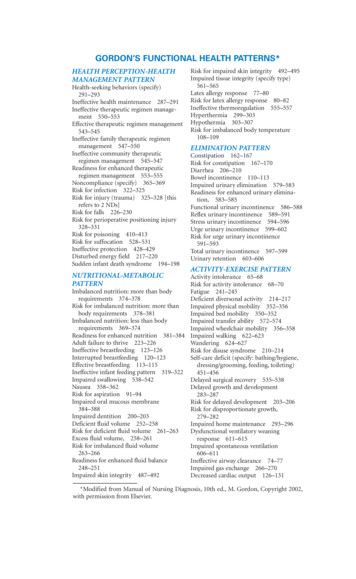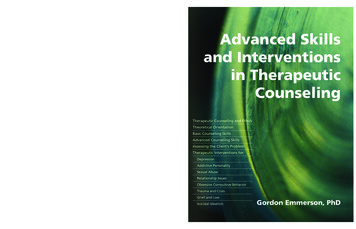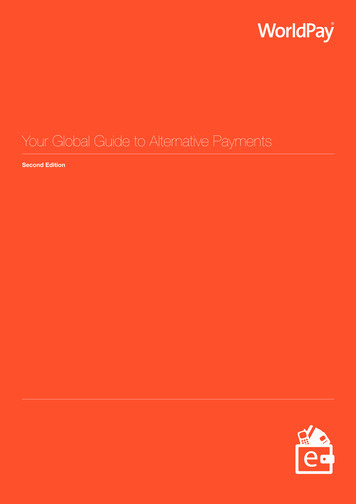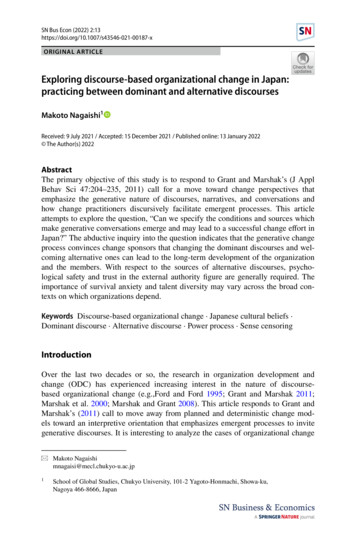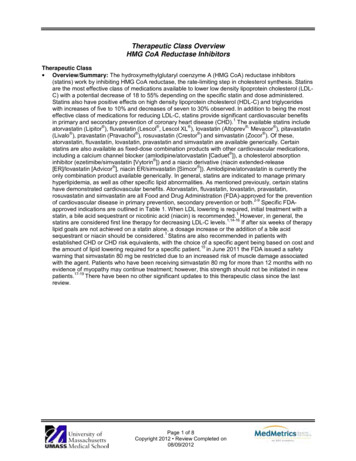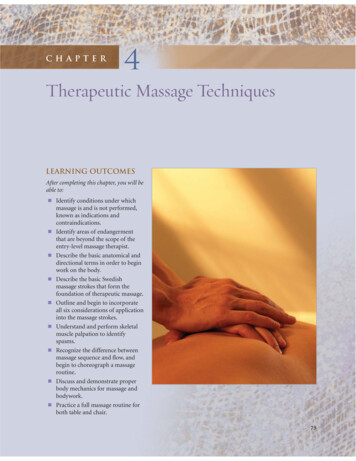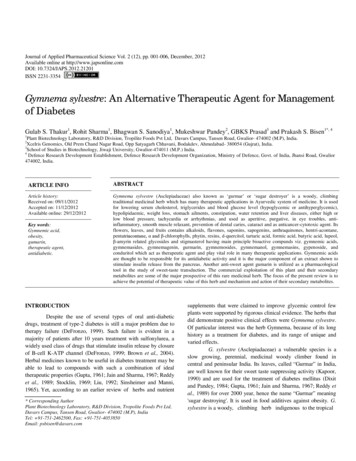
Transcription
Journal of Applied Pharmaceutical Science Vol. 2 (12), pp. 001-006, December, 2012Available online at http://www.japsonline.comDOI: 10.7324/JAPS.2012.21201ISSN 2231-3354Gymnema sylvestre: An Alternative Therapeutic Agent for Managementof DiabetesGulab S. Thakur1, Rohit Sharma1, Bhagwan S. Sanodiya1, Mukeshwar Pandey2, GBKS Prasad3 and Prakash S. Bisen1*, 41Plant Biotechnology Laboratory, R&D Division, Tropilite Foods Pvt Ltd, Davars Campus, Tansen Road, Gwalior- 474002 (M.P), India.Xcelris Genomics, Old Prem Chand Nagar Road, Opp Satyagarh Chhavani, Bodakdev, Ahmedabad- 380054 (Gujrat), India.School of Studies in Biotechnology, Jiwaji University, Gwalior-474011 (M.P.) India.4Defence Research Development Establishment, Defence Research Development Organization, Ministry of Defence, Govt. of India, Jhansi Road, Gwalior474002, India.23ARTICLE INFOABSTRACTArticle history:Received on: 09/11/2012Accepted on: 11/12/2012Available online: 29/12/2012Gymnema sylvestre (Asclepiadaceae) also known as ‘gurmar’ or ‘sugar destroyer’ is a woody, climbingtraditional medicinal herb which has many therapeutic applications in Ayurvedic system of medicine. It is usedfor lowering serum cholesterol, triglycerides and blood glucose level (hypoglycemic or antihyperglycemic),hypolipidaemic, weight loss, stomach ailments, constipation, water retention and liver diseases, either high orlow blood pressure, tachycardia or arrhythmias, and used as aperitive, purgative, in eye troubles, antiinflammatory, smooth muscle relaxant, prevention of dental caries, cataract and as anticancer-cytotoxic agent. Itsflowers, leaves, and fruits contains alkaloids, flavones, saponins, sapogenins, anthraquinones, hentri-acontane,pentatriacontane, α and β-chlorophylls, phytin, resins, d-quercitol, tartaric acid, formic acid, butyric acid, lupeol,β-amyrin related glycosides and stigmasterol having main principle bioactive compunds viz. gymnemic acids,gymnemasides, gymnemagenin, gurmarin, gymnemosides, gymnemanol, gymnemasins, gypenoside, andconduritol which act as therapeutic agent and play vital role in many therapeutic applications. Gymnemic acidsare thought to be responsible for its antidiabetic activity and it is the major component of an extract shown tostimulate insulin release from the pancreas. Another anti-sweet agent gumarin is utilized as a pharmacologicaltool in the study of sweet-taste transduction. The commercial exploitation of this plant and their secondarymetabolites are some of the major prospective of this rare medicinal herb. The focus of the present review is toachieve the potential of therapeutic value of this herb and mechanism and action of their secondary metabolites.Key words:Gymnemic acid,obesity,gumarin,therapeutic agent,antidiabetic.INTRODUCTIONDespite the use of several types of oral anti-diabeticdrugs, treatment of type-2 diabetes is still a major problem due totherapy failure (DeFronzo, 1999). Such failure is evident in amajority of patients after 10 years treatment with sulfonylurea, awidely used class of drugs that stimulate insulin release by closureof B-cell K-ATP channel (DeFronzo, 1999; Brown et al., 2004).Herbal medicines known to be useful in diabetes treatment may beable to lead to compounds with such a combination of idealtherapeutic properties (Gupta, 1961; Jain and Sharma, 1967; Reddyet al., 1989; Stocklin, 1969; Liu, 1992; Sinsheimer and Manni,1965). Yet, according to an earlier review of herbs and nutrient.* Corresponding AuthorPlant Biotechnology Laboratory, R&D Division, Tropolite Foods Pvt Ltd,Davars Campus, Tansen Road, Gwalior- 474002 (M.P), IndiaTel: 91-751-2462500, Fax: 91-751-4053850Email: psbisen@davars.comsupplements that were claimed to improve glycemic control fewplants were supported by rigorous clinical evidence. The herbs thatdid demonstrate positive clinical effects were Gymnema sylvestre.Of particular interest was the herb Gymnema, because of its longhistory as a treatment for diabetes, and its range of unique andvaried effects.G. sylvestre (Asclepiadaceae) a vulnerable species is aslow growing, perennial, medicinal woody climber found incentral and peninsular India. Its leaves, called “Gurmar” in India,are well known for their sweet taste suppressing activity (Kapoor,1990) and are used for the treatment of diabetes mellitus (Dixitand Pandey, 1984; Gupta, 1961; Jain and Sharma, 1967; Reddy etal., 1989) for over 2000 year, hence the name “Gurmar” meaning'sugar destroying'. It is used in food additives against obesity. G.sylvestre is a woody, climbing herb indigenous to the tropical
002Thakur et al. / Journal of Applied Pharmaceutical Science 2 (12); 2012: 001-006forests of central and southern India. The plant belongs toKingdom Plantae with Division Angiospermae and ClassDicotyledoneae. Gymnema is native to south-Indian forests. It is alarge tropical liana native to central and western India and can bealso found in tropical Africa and in Australia (Stocklin, 1969).The current review is aimed at providing an overview onethnomedicinal, pharmacological studies including clinical andexperimental studies, hypoglycemic and anti-hyperglycemicactivities of plants, active hypoglycemic compounds andconstituents along with their available toxicity status.thereby curbing the sugar craving. Similarly, Gymnemic acidmolecules fill the receptor location in the absorptive externallayers of the intestine thereby preventing the sugar moleculesabsorption by the intestine, which results in low blood sugar level(Sahu et al., 1996). Structure of gymnemic acid andgymnemagenin is shown in Fig. 1 and 2.CHEMICAL CONSTITUENTS AND BIOACTIVECOMPONENTSThe anti-diabetic array of molecules has been identifiedas a group of closely related gymnemic acids after it wassuccessfully isolated and purified from the leaves of G. sylvestre(Liu 1992; Sinsheimer and Manni, 1965). Later, thephytoconstituents of G. sylvestre were isolated, and their chemistryand structures were studied and elucidate (Sinsheimer and Manni,1965; Sinsheimer et al., 1970; Yoshikawa et al., 1989; Yoshikawaet al., 1992). Gymnemic acids, a group of triterpenoid saponinsbelonging to oleanane and dammarene classes. Oleanane saponinsare gymnemic acids and gymnemasaponins, while dammarenesaponins are gymnemasides. Gymnemic acids Ι-VΙ were isolatedand characterized from aqueous leaf extracts and gymnemic acidsXV-XVΙΙΙ from the saponin fraction of the leaves. Gymnemicacids VΙΙΙ-XΙΙ have been elucidated as glucosideuronic acidderivatives of gymnemagenin (Porchezhian and Dobriyal, 2003).Gymnemic acids are thought to be responsible for the antidiabeticactivity of G. sylvestre; gymnemic acid VΙΙΙ was the majorcomponent of an extract shown to stimulate insulin release fromthe pancreas (Persaud et al., 1999).Gymnema saponins Ι-V, groups of anti-sweet principleswith a novel D-glucoside structure are also present in gymnemaextracts. Besides this, other plant constituents are flavones,anthraquinones, hentri-acontane, pentatria contane, α and βchlorophylls, phytin, resins, d-quercitol, tartaric acid, formic acid,butyric acid, lupeol, β-amyrin related glycosides and stigmasterol.The plant extract also tests positive for alkaloids. The structure ofgurmarin, another anti-sweet agent found in gymnema, has beenelucidated as a polypeptide comprising 35 amino acid residues(Fletcher et al., 1999).Mechanism of Action of Gymnemic AcidsThe main constituent of gymnema is believed to begymnemic acid, a mixture of at least 17 different saponins.Gymnemic acid formulations have been found useful againstobesity, according to recent reports (Yoshikawa et al., 1993). Thisis attributed to the ability of gymnemic acids to delay the glucoseabsorption in the blood. The atomic arrangement of gymnemicacid molecules is similar to that of glucose molecules. Thesemolecules fill the receptor locations on the taste buds therebypreventing its activation by sugar molecules present in the food,Fig. 1: Structure of gymnemic acid.Fig. 2: Structure of Gymnemagenin.There are some possible mechanisms by which the leavesand especially Gymnemic acids from G. sylvestre exert itshypoglycemic effects are: It increases secretion of insulin It promotes regeneration of islet cells It increases utilization of glucose: It is shown to increasethe activities of enzymes responsible for utilization ofglucose by insulin-dependent pathways, an increase inphosphorylase activity, decrease in gluconeogenicenzymes and sorbitol dehydrogenase and It causes inhibition of glucose absorption from intestine,the exact action being unknown. It could be involve oneor more mechanisms (Nakamura et al., 1999).Ethnomedicinal usesGymnema has played an important role in Ayurvedicmedicine for centuries. Its use has been confined primarily to themanagement of diabetes mellitus and similar hypo/hyperglycemicconditions. As early as 1930, the pharmacological effect of theplant was investigated. The leaves also have been used forstomach ailments, constipation, water retention, and liver disease.The flowers, leaves, and fruits have been used in the treatment ofeither high or low blood pressure, tachycardia or arrhythmias.Chewing the leaves destroys the ability to discriminate the sweettaste, giving it the common Hindi name of gurmar, or “sugardestroyer.” According to the Ayurvedic Pharmacopoeia of India,both the dried leaf and root of gymnema, depending on dosage
Thakur et al. / Journal of Applied Pharmaceutical Science 2 (12); 2012: 001-006form and formulation, are also used in the treatment of svasa(bronchial asthma), kasa (cough), kustha (leprosy and other skindiseases), and vrana (wounds), among other conditions.According to Charak Samhita, it removes bad odor frombreast milk. It is aperitive. This plant is useful as purgative, in eyetroubles. The leaf extract and flower is beneficial for eyes. Bark isgiven in the diseases caused by vitiated kapha (phlegm). The rootbark is useful in piles. According to the Ayurveda it is acrid,alexipharmic, anodyne, anthelmintic, antipyretic, astringent, bitter,cardiotonic, digestive, diuretic, emetic, expectorant, laxative,stimulant, stomachic, uterine tonic; useful in amennorrhoea,asthma, bronchitis, cardiopathy, conjunctivitis, enomegaly,inflammations, intermittant fever, jaundice and leucoderma. Alsoit is used for the treatment of dysentery in North Coastal areas ofAndhra Pradesh, India (Pragada et al., 2012)Pharmacological AspectsG. sylvestre is one of the indispensable medicinal plantsused in Ayurvedic system of medicine for the treatment of diversediseases (Fig. 3) and are well known for their sweet tastesuppressing activity and are used for the treatment of diabetesmellitus. It is used in food additives against obesity. Authors grouppreviously described some medicinal plants and biological entities(macrofungus) as golden gift for human kind (Thakur et al., 2009;Thankur et al., 2009; Sanodiya et al., 2009). In continuation, G.sylvestre has been the subject of extensive phytochemical andbioactive investigations due to its importance in traditional folkand Ayurvedic system of medicine.Fig. 3: Medicinal Properties of Gymnema sylvestre.Gymnema sylvestre in Diabetes MellitusExperimental studies, for instance, have found that manyof the constituents in Gymnema decrease the uptake of glucosefrom the small intestine. Gymnema has also demonstratedimprovements in glycogen synthesis, glycolysis, gluconeogenesis,and hepatic and muscle glucose uptake, as well as the reversal ofhemoglobin and plasma protein glycosylation. Some authoritiesalso indicate that gymnema may improve glycemic control by003stimulating insulin release from the pancreatic islets ofLangerhans.Hypoglycemic activity or antihyperglycemic activityGymnema sylvestre has long been used as a treatment fordiabetes (Nakamura et al., 1999; Sahu et al., 1996; Murray, 1999).When Gymnema leaf extract is administered to a diabetic patient,there is stimulation of the pancreas by virtue of which there is anincrease in insulin release (Kanetkar et al., 2004). Thesecompounds have also been found to increase fecal excretion ofcholesterol (DeFronzo, 1999).A number of studies have evaluated the effects of G.sylvestre on blood sugar in animals (Rahman et al., 1989). In onetypical study, diabetic rats received an alcoholic extract of G.sylvestre (100 mg/kg/day) for 1 month (Gupta and Seth, 1962). Bythe second week, the mean blood sugar level was lower amonganimals receiving the Gymnema extract (74 mg/dL) than amongthe control group (106 mg/dL).This difference was maintained throughout the study. Ablood glucose-lowering effect of similar magnitude produced bytolbutamide has been demonstrated. It should be noted that thedoses used would be equivalent to a 7 g dose for a typical man(Gupta and Seth, 1962). A more dramatic effect was noted whenthe extract was administered parenterally to rats (Gupta andVariyar, 1964).Shanmugasundaram et al., (1990) investigated thatpatients received 200 mg Gymnema powder twice daily inaddition to their usual doses of insulin, mean glycosylatedhemoglobin (HbA 1c) decreased significantly from baseline (12.8to 9.5%) at 6 months in a controlled trial of patients with type 1diabetes. Mozersky, (1999) reported that 22 patients were given G.sylvestre extract along with their oral hypoglycemic drugs. Allpatients demonstrated improved blood sugar control. Twenty-oneout of the twenty-two were able to reduce their oral hypoglycemicdrug dosage considerably, and five patients were able todiscontinue their oral medication and maintain blood sugar controlwith the extract alone.The effects of an alcoholic extract of G. sylvestre (GS4)on insulin secretion from islets of Langerhans and severalpancreatic β-cell lines were examined by Persaud et al., (2009).GS4 stimulated insulin release from β-cells and from islets in theabsence of any other stimulus, and GS4-stimulated insulinsecretion was inhibited in the presence of 1mM EGTA.Persaud et al., (2009) examined the effects of a novelGymnema extract on insulin secretion from the MIN6 –cell lineand isolated human islets of Langerhans. Insulin secretion fromMIN6 cells was stimulated by OSA in a concentration-dependentmanner, with low concentrations (0.06- 0.25mg/ml) having nodeleterious effects on MIN6 cell viability, while higherconcentrations (0.5mg/ml) caused increased Trypan blue uptake.Normal and streptozotocin-induced diabetic rats were treated witheither a 50% ethanolic extract of Gymnema leaves (GS3, 20mg/day/rat), a purified residue of GS3 (GS4, 20 mg/day/rat), or nointervention for up to 95 days (Shanmugasundaram et al., 1988).
004Thakur et al. / Journal of Applied Pharmaceutical Science 2 (12); 2012: 001-006Hypolipidaemic ActivityIn a study conducted on experimentally inducedhyperlipidaemic rats the leaf extract at a dosage of 25-100 mg/kgadministered orally for two weeks reduced the elevated serumtriglyceride (TG), total cholesterol (TC), very low densitylipoprotein (VLDL) and low density lipoprotein (LDL)-cholesterolin a dose dependent manner. The ability of the extract at 100mg/kgto lower TG and TC in serum and its antiantheroscelrotic potentialwere almost similar to that of a standard lipid lowering agentclifibrate (Bishayee and Chatterjee, 1994).In another study a dose-dependent increase in fecalcholesterol and cholic acid-derived bile acid excretion has beendemonstrated in rats (Nakamura et al., 1999). A 3-week studyshowed a decrease in apparent fat digestibility and an increase inexcretion of neutral sterols and acidic steroids in rats receiving anextract of G. sylvestre leaves and either a normal or high-fat diet.Total serum cholesterol and triglycerides also were decreasedsignificantly (Shigematsu et al., 2001). After 10 weeks, plasmatriglycerides were lower in Gymnema-fed rats than in controls, butthe difference in plasma total cholesterol levels was no longersignificant (Shigematsu et al., 2001). An aqueous extract of theleaf was effective in reducing serum lipids in 27 insulin dependentdiabetic patients taking insulin only, when treated with 400mg/day. Serum levels of lipids returned to near normal.Weight LossAn increase in body weight was significantly suppressedin a long-term study of the administration of G. sylvestre extract inrats fed a high-fat diet. However, in rats receiving a normal diet,no significant suppression of weight gain was observed(Shigematsu et al., 2001). Use of a dietary supplement containingG. sylvestre in combination with glucomannan, chitosan,fenugreek, and vitamin C was investigated in obese adults (bodymass index 30 kg/m 2 or more) (Woodgate and Conquer, 2003).Compared with placebo recipients, the treatment group lostsignificantly more body weight, and percentage of body fat andabsolute fat mass were significantly reduced. Reduction in upperabdominal, waist, and hip circumferences also was demonstratedin patients receiving active treatment.The effect of Gymnema on body weight, glucoseabsorption and lipid metabolism was examined by using a breed offatty rats with genetic obese-hyperglycaemia.Sweet Taste Suppression ActivityThe antisweet principles of Gymnema include gymnemicacids, gymnemasaponins and gurmarin. Gymnemasaponinscompletely inhibited the perception of sweetness induced by a 0.1M sucrose solution. The reduced sensitivity to sweet substancesproduced by Gymnema might result from the competition at thereceptor sites between glycosides and the sweet substances. Anelectrophysiological study on taste responses in rats suggests thatgurmarin acts on the apical side of the taste cell, possibly bybinding to the sweet taste receptor protein (Miyasaka and Imoto,1995). A gymnemic acid rinse used by human volunteers reducedthe intensities of sucrose and aspartame to 14% of their pre-rinselevels (Gent et al., 1999).Experimental evidenceEffect of Gymnema powder on Blood Glucose Level and LipidProfile on Human SubjectsThe present study was conducted by the authors atDiabetes camp, School of Studies in Biotechnology, JiwajiUniversity, Gwalior (M.P) to study the effect of gurmar leafpowder intervention on the blood glucose level and Lipid profileof 20 non-insulin dependent diabetic human subjects (n 15), (4060) years residing in the Gwalior city, Madhya Pradesh.Information regarding name, age, religion, lifestyle pattern, wascollected with the help of interview schedule.All the subjects were divided in to three groups of 15subjects each (Group I, II, III) whose FBG values were 200mg/dl , cholesterol levels were 200 mg/dl, triglycerides levelswere found to be 150 mg/dl and VLDL levels were found tobe 150 mg/dl. Group I included diabetic control group whichreceived standard allopathic antidiabetic drugs. Group II, whichreceived Gymnema powder (1 gm/day) and the Group III, whichreceived mixture of Gymnema powder and standard allopathicantidiabetic drugs (1 gm/day) for 90 days. It was observed formthe study that administration of dosage before meals to thesegroups reduced the FBG levels by 16.3%, 12.9 %, 26.6% and PPlevels by 13.17%, 24.8 %, 47.21% respectively in Group I, II andIII. Similarly the lipid levels such as Total Cholesterol,triglycerides, LDL, VLDL,were also found to reducesignificantly by 38 %, 31.3 % , 45 % and 31.7 % respectively.Hence, it was concluded form the study that GS supplementationcan be advocated to subjects with metabolic syndrome.GYMNEMA IN OBESITYObesity and its effect on human bodyObesity and associated type 2 diabetes mellitus are theemerging epidemic of this new century. It is characterized by theincreased storage of triglycerides (fat molecules) in adipose tissuethereby causing insulin resistance. It could also be defined as thecondition of a human being in which the body contains more fatthan required and which can lead to a disease state.Resistin, also known as adipocyte-secreted factor andFIZZ3, (Kim et al., 2001; Holcomb et al., 2000) is a 12.5-kDacysteine-rich protein that is specifically expressed in white adiposetissue. It has been proposed that elevated plasma resistin levels inrodent models of obesity could be causative in the development ofinsulin resistance and that resistin may be a link between obesityand type-2 diabetes. In keeping with this hypothesis, resistin wasshown to be down-regulated by the antidiabetic drug rosiglitazonein white adipose tissue of mice, suggesting that suppression ofresistin expression could be one of the underlying mechanisms forthe beneficial effects of thiazolidinediones in insulin-resistantstates (Steppan et al., 2001). Along the same line, acutehyperglycemia under normoinsulinemic conditions led to up-
Thakur et al. / Journal of Applied Pharmaceutical Science 2 (12); 2012: 001-006regulation of resistin transcription in various adipose depots(Rajala et al., 2002) (Fig. 4).005in mice, no gross behavioral, neurologic, or autonomic effectswere observed. The acute LD 50 was 3990 mg/kg. The safety ratio(LD 50 /ED 50) was 11 and 16 in normal and diabetic rats,respectively (Chattopadhyay, 1999).CONCLUSION AND FUTURE PROSPECTSFig. 4: Resistin and its area of linkage.Linkage between Obesity, Diabetes and Gymnemic acidsFrom the above aspects of the diseases i.e. obesity,diabetes mellitus and gymnemic acids, a linkage amongst them isquite clear. The diagrammatic representation shown below willgive an idea as to how the three are inter-linked. Hence, it isobvious that same medicine can be used for curing of both thedisease. Obesity is the main consequence from the accumulation ofthe carbohydrates and fats. Gymnemic acids cure the binding ofcarbohydrates to the receptors in the intestine and hence, the“empty calories” are taken care of so that the body does not gointo obese stage. The acids are also useful in curbing of diabetesby a similar mechanism as mentioned above for carbohydrate.Currently, gymnemic acids are being sold in the form ofGymnema Tea, for curing obesity (Flier, 2001) (Fig. 5).Gymnema Leaves has been used by natural clinics inIndia for centuries to support healthy blood sugar levels. The tasteof Gymnema suppresses the ability to detect sweet tastes. It has animportant place among such antidiabetic medicinal herbs. It hasshown experimental or clinical anti-diabetic activity and it boostsour insulin level. Since each part of G.sylvestre has somemedicinal property, it is very much commercially exploitable.During the last few decades considerable progress has beenachieved regarding its biological activity and medicinalapplications. Hence, it can be chosen as a source for thedevelopment of industrial products for treatment of diabetesmellitus. Medicinal value of this herb has become a matter of greatsignificance particularly its antidiabetic action which is reportedby several researchers but the mechanism of action of G. sylvestreis not yet clearly understood.However, there are currently no standard protocols forguaranteeing its product for quality and efficacy. From apharmacological point of view, safety is a relative concept and itshould be clear by further appropriate research in this direction. Asystematic research should be undertaken to develop a moderndrug using compounds isolated from this climbing shrub. Amodern effective and safe drug can be developed after extensiveinvestigation of its pharmacodynamics, kinetics, properstandardization and clinical trials. An extensive research should beundertaken on this herb and its products including standardizationof various parts and subparts and drug development program usingG.sylvestre compounds for their better economic and therapeuticutilization. Further research is needed to establish content andbioactivity of the many compounds present, their mode of actionsand the effect of preparation and consumption differences on theirmedicinal activity.ACKNOWLEDGEMENTAuthors are thankful to Council of Scientific andIndustrial Research (CSIR), New Delhi for the award of EmeritusScientist to Prof. P.S. Bisen.Fig. 5: Linkage between Obesity, Diabetes mellitus and Gymnemic acids.TOXICOLOGICAL AND SAFETY EVALUATIONNo adverse reactions were reported in a long-term studyof insulin-dependent diabetic patients (Shanmugasundaram et al.,1990). However, consider the possibility of hypoglycemia.Systolic blood pressure was raised in spontaneously hypertensiverats fed a high sucrose diet. The clinical significance of thisfinding is unknown (Preuss et al., 1998). In an acute toxicity icandantiatherosclerotic effect of oral Gymnema sylvestre R.Br. leaf extract inalbino rats fed on a high fat diet. Phytotherapy Res. 1994; 8: 118-120.Brown JB., Nichols GA., Perry A. The burden of treatmentfailure in type 2 diabetes. Diabetes Cr. 2004; 27: 1535–1540.Chattopadhyay RR. A comparative evaluation of some bloodsugar lowering agents of plant origin. J Ethnopharmacol. 1999; 67: 367372.DeFronzo RA. Pharmacologic therapy for type 2 diabetesmellitus. Annals Inter Med. 1999; 131: 281–303.
006Thakur et al. / Journal of Applied Pharmaceutical Science 2 (12); 2012: 001-006Dixit RS., Pandey HC. Plant used as folk-medicine in Jhansiand Lalitpur sections of Bundelkhand, Uttar Pradesh. Int J Crude DrugRes. 1984; 22: 47–51.Fletcher JI., Dingley AJ., Smith R et al. High-resolutionsolution structure of gurmarin, a sweet-taste-suppressing plantpolypeptide. Eur J Biochem. 1999; 264: 525-533.Flier JS. Prevention of obesity reduces the risk of a wide rangeof health problems, The missing link with obesity. Nature, 2001; 409: 292293.Gent JF., Thomas P., Hettinger. Taste Confusions followingGymnemic Acid Rinse. Chem Senses. 1999; 24: 393-403.Gupta SS. Inhibitory effect of Gymnema sylvestre (Gurmar) onadrenaline induced hyperglycemia in rats. Ind J Med Sci. 1961; 15: 883–887.Gupta SS., Seth CB. Experimental studies on pituitary diabetesII: Comparison of blood sugar level in normal and anterior pituitaryextract induced hyperglycemic rats treated with a few Ayurvedic remedies.Indian J Med Res. 1962; 50: 708-714.Gupta SS., Variyar MC. Experimental studies on pituitarydiabetes IV: Effect of Gymnema sylvestre and Coccinia indica against thehyperglycaemic response of somatotropin and corticotropin hormone.Indian J Med Res. 1964; 52: 200-207.Holcomb IN., Kabakoff RC., Chan B., et al. A novel cysteinerich secreted protein associated with pulmonary inflammation, defines anew gene family. EMBO J. 2000; 19: 4046–4055.Jain SR., Sharma SN. Hypoglycaemic drugs of Indianindigenous origin. Planta Med. 1967; 15: 439–442.Kanetkar PV., Laddha KS., Kamat MY. Gymnemic acids: Amolecular perspective of its action on carbohydrate metabolism, Posterpresented at the 16th ICFOST meet organized by CFTRI and DFRL,Mysore, India, 2004.Kapoor LD. CRC Handbook of Ayurvedic Medicinal Plants;CRC, Boca Raton. 1990; 200–201.Kim KH., Lee K., Moon YS., Sul HS. A cysteine-rich adiposetissue-specific secretory factor inhibits adipocyte differentiation. J BiolChem. 2001; 276: 11252–11256.Liu HM., Kiuchi F., Tsuds Y. Isolation and structure elucidationof Gymnemic acids, antisweet principles of Gymnema sylvestre. ChemPharm Bull. 1992; 40: 1366-1375.Miyasaka A., Imoto T. Electrophysiological characterization ofinhibitory effect of a novel peptide gurmarin on the sweet taste response inrats. Brain Res. 1995; 676: 63 –68.Mozersky RP. Herbal products and supplemental nutrients usedin the management of diabetes. J Am Osteopath Assoc. 1999; 12: S4–S9.Murray., Pizzorno Jr JE. Diabetes mellitus. In: Pizzorno Jr JE,Murray MT, editors, Textbook of Natural Medicine, second edition.,Churchill Livingstone, New York., 1999; 1193–1218.Nakamura Y., Tsumura Y., Tonogai Y., Shibata T. Fecal steroidexcretion is increased in rats by oral administration of gymnemic acidscontained in Gymnema sylvestre leaves. J Nutr. 1999; 129: 1214–1222.Persaud SJ, Al-Majed H, Raman A, Jones PM. Gymnemasylvestre stimulates insulin release in vitro by increased membranepermeability. J Endocrinol. 1999; 163: 207-212.Persaud SJ., Bo Liu., Henry AA., et al. Characterisation of theInsulinotropic Activity of an Aqueous Extract of Gymnema sylvestre inMouse-Cells and Human Islets of Langerhans. Int J Exp Clinc Cell PhysiolBiochem Pharmacol. 2009; 23: 1-3.Porchezhian E., Dobriyal RM. An overview on the advances ofGymnema sylvestre: chemistry, pharmacology and patents. Pharmazie.2003; 58: 5-12.Pragada PM., Rao DS., Venkaiah M. Study of someethnomedicinal plants for treatment of dysentery of North Coastal AndhraPradesh, India. Int J Biosci. 2012; 2(1): 18-24.Preuss HG., Jarrell ST., Scheckenbach R., et al. Comparativeeffects of chromium, vanadium and Gymnema sylvestre on sugarinducedblood pressure elevations in SHR. J Am Coll Nutr. 1998; 17: 116-123.Rahman AU., Zaman K. Medicinal plants with hypoglycemicactivity. J Ethnopharmacol. 1989; 26: 73.Rajala MW., Lin Y., Ranalletta M., et al. Cell type-specificexpression and coregulation of murine resistin and resistin-like moleculein adipose tissue. Mol Endocrinol. 2002; 16: 1920–1930.Reddy MB., Reddy KR., Reddy MN. A survey of plant crudedrugs of Anantapur district, Andhra Pradesh, India. Int J Crude Drug Res.1989; 3: 145–155.Sahu N., Mahato SB., Sarkar SK., Poddar G. Triterpenoidsaponis from Gymnema Sylvestre. Phytochem. 1996; 41: 1181-1185.Sanodiya BS., Thakur GS., Baghel RK., et al. Ganodermalucidum: A Potent Pharmacological Macrofungi. Curr Pharm Biotechnol.2009; 10: 717-742.Shanmugasundaram E., Gopinath K., Shanmugasundaram K.,Rajendran V. Possible regeneration of the Islets of Langerhans inStreptozotocin-diabetic rats given Gymnema sylvestre leaf extracts. JEthnopharmacol. 1990; 30: 265–279.Shanmugasundaram E., Venkatasubrahmanyam M., VijendranN., Shanmugasundaram K. Effect of an isolate from Gymnema sylvestre,R.Br. in the control of diabetes mellitus and the associated pathologicalchanges. Ancient Sci Life. 1988; 7: 183–194.Shigematsu N., Asano R., Shimosaka M., Okazaki M. Effect ofadministration with the extract of Gymnema sylvestre R.Br
Gymnema sylvestre (Asclepiadaceae) also known as ‘gurmar’ or ‘sugar destroyer’ is a woody, climbing traditional medicinal herb which has many therapeutic applications in Ayurvedic system of medicine. It is used for lowering serum cholesterol, triglycerides and

